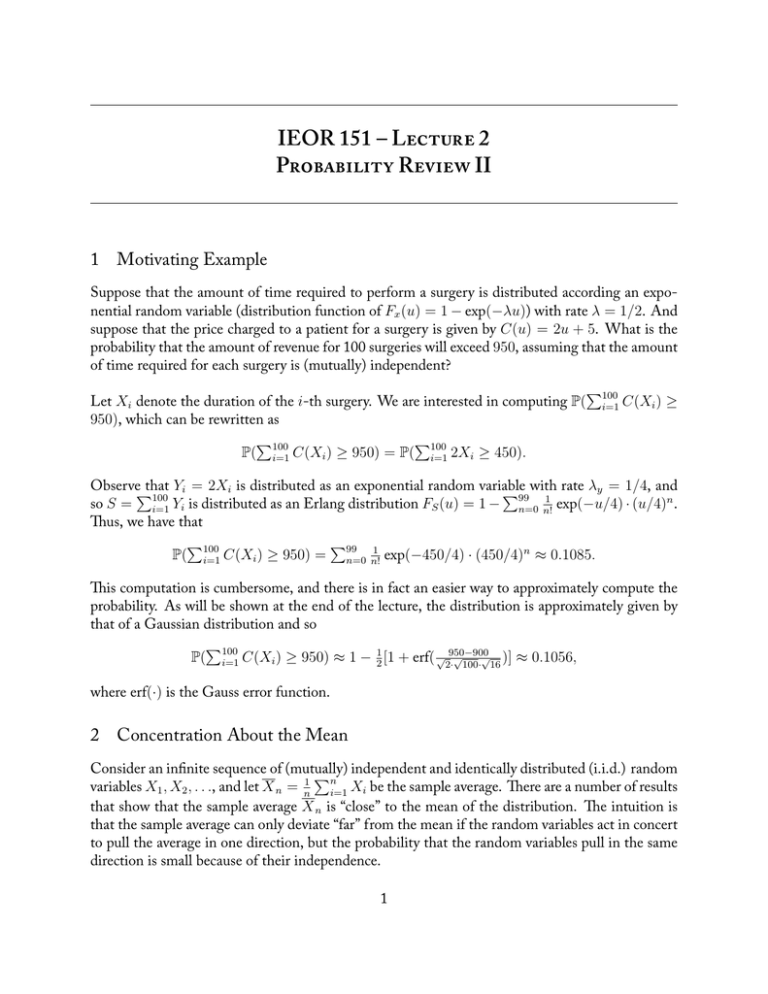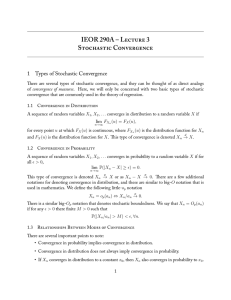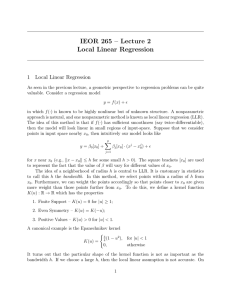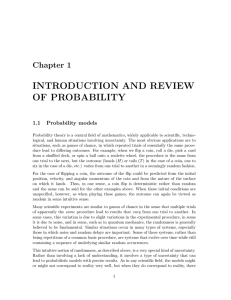IEOR 151 – L 2 P R II 1 Motivating Example
advertisement

IEOR 151 – L 2
P R II
1
Motivating Example
Suppose that the amount of time required to perform a surgery is distributed according an exponential random variable (distribution function of Fx (u) = 1 − exp(−λu)) with rate λ = 1/2. And
suppose that the price charged to a patient for a surgery is given by C(u) = 2u + 5. What is the
probability that the amount of revenue for 100 surgeries will exceed 950, assuming that the amount
of time required for each surgery is (mutually) independent?
Let Xi denote the duration of the i-th surgery. We are interested in computing P(
950), which can be rewritten as
∑
∑100
P( 100
C(X
)
≥
950)
=
P(
i
i=1
i=1 2Xi ≥ 450).
∑100
i=1
C(Xi ) ≥
Observe∑that Yi = 2Xi is distributed as an exponential random variable
rate λy = 1/4, and
∑99 with
100
1
so S = i=1 Yi is distributed as an Erlang distribution FS (u) = 1 − n=0 n! exp(−u/4) · (u/4)n .
us, we have that
∑
∑99 1
n
P( 100
i=1 C(Xi ) ≥ 950) =
n=0 n! exp(−450/4) · (450/4) ≈ 0.1085.
is computation is cumbersome, and there is in fact an easier way to approximately compute the
probability. As will be shown at the end of the lecture, the distribution is approximately given by
that of a Gaussian distribution and so
∑
1
√
√
√ 950−900
P( 100
i=1 C(Xi ) ≥ 950) ≈ 1 − 2 [1 + erf( 2· 100· 16 )] ≈ 0.1056,
where erf(·) is the Gauss error function.
2
Concentration About the Mean
Consider an infinite sequence of (mutually)
∑ independent and identically distributed (i.i.d.) random
variables X1 , X2 , . . ., and let X n = n1 ni=1 Xi be the sample average. ere are a number of results
that show that the sample average X n is “close” to the mean of the distribution. e intuition is
that the sample average can only deviate “far” from the mean if the random variables act in concert
to pull the average in one direction, but the probability that the random variables pull in the same
direction is small because of their independence.
1
2.1
W L L N
p
If the random variables Xi have a finite first moment E|Xi | < ∞, then X n → µ where µ = E(Xi ).
In words — the weak law of large numbers states that if i.i.d. random variables have a finite first
moment, then their sample average converges in probability to the mean of the distribution.
2.2
C L T
A more precise statement of the convergence of sample averages is given by the following theorem:
If the random variables Xi with mean E(Xi ) = µ have a finite variance Var(Xi ) = σ 2 < ∞, then
√
d
n(X n − µ) → N (0, σ 2 ),
where N (0, σ 2 ) is the distribution of a Gaussian random variable with mean 0 and variance σ 2 .
is is a more precise statement because it describes the distribution of the sample average when it
√
d
is appropriately scaled by n. is scaling is important because otherwise X n → µ by the weak law
of large numbers (and the fact that convergence in probability implies convergence in distribution).
3
Extensions of Central Limit eorem
ere are a number of extensions of the Central Limit eorem, but understanding and deriving
these extensions requires several useful results.
3.1
C M T
Suppose that g(u) is a continuous function. e continuous mapping theorem states that convergence of a sequence of random variables {Xn } to a limiting random variable X is preserved under
continuous mappings. More specifically:
d
d
p
p
• If Xn → X, then g(Xn ) → g(X).
• If Xn → X, then g(Xn ) → g(X).
3.2
S’ T
p
d
If Xn → X and Yn → y0 , where y0 is a constant, then
d
• X n + Y n → X + y0 ;
d
• Yn Xn → y0 X;
ere is a technical point to note about this theorem: Convergence of Yn to a constant is a subtle but
important feature for this result, because the theorem will not generally hold when Yn converges to
a non-constant random variable. Consider the example where Xn ∼ N (0, 1) and Yn = Xn , then
Xn + Yn = N (0, 4) which obviously does not converge in distribution to N (0, 1) + N (0, 1) =
N (0, 2).
2
3.3
D M
Using the Continuous Mapping eorem and Slutsky’s eorem, we can now state and derive an
extension of the Central Limit eorem. Consider an infinite sequence of random variables {Xn }
that satisfies
√
d
n[Xn − θ] → N (0, σ 2 ),
where θ and σ 2 are finite constants. If g(u) is continuously differentiable at θ and g ′ (θ) ̸= 0, then
√
d
n[g(Xn ) − g(θ)] → g ′ (θ)N (0, σ 2 ).
To derive this result, which is known as the Delta Method, we will need to use the “zeroth-order”
Lagrange form of Taylor’s eorem. is result states that there exists some ξ(u, θ) in between u
and θ such that
g(u) = g(θ) + g ′ (ξ(u, θ))(u − θ).
is theorem is also known as the Mean Value eorem.
√
First, note that because 1/ n → 0 as n → ∞, then Slutsky’s eorem implies
√ √
p
1/ n · n[Xn − θ] = Xn − θ → 0 · N (0, σ 2 ) = 0.
p
us, Xn − θ → 0. Now using the form of Taylor’s eorem stated above, we have
√
√
√
n[g(Xn ) − g(θ)] = n[g(θ) + g ′ (ξ(Xn , θ))(Xn − θ) − g(θ)] = n[g ′ (ξ(Xn , θ))(Xn − θ)].
p
But because |ξ(Xn , θ) − θ| ≤ |Xn − θ| and Xn − θ → 0 (as shown above), we have that |ξ(Xn , θ) −
p
p
θ| → 0 and so ξ(Xn , θ) → θ. Because g ′ (u) is continuous at θ by assumption, we can apply the
p
Continuous Mapping eorem to infer that g ′ (ξ(Xn , θ)) → g ′ (θ). Next, we can apply Slutsky’s
√
p
d
eorem to the two facts (i) n[Xn − θ] → N (0, σ 2 ) and (ii) g ′ (ξ(Xn , θ)) → g ′ (θ), to conclude
√
d
n[g(Xn ) − g(θ)] → g ′ (θ)N (0, σ 2 ).
is is the result that was to be shown.
4
Motivating Example, cont.
Returning to the motivating example presented above, we can apply the Delta Method to approximate the probability to be computed. By the Central Limit eorem and for an exponential
√
d
distribution with rate of λ = 1/2, we have n[X n − 2] → N (0, 4). Applying the Delta Method
√
d
to C(u) = 2u + 5, we have n[C(X n ) − 9] → N (0, 16). But
∑100
√ √
n · n[C(X n ) − 9] + 9n.
i=1 C(Xi ) = nC(X n ) =
√
∑100
Hence, we can approximate the probability P( i=1 C(Xi ) ≥ 950) by the distribution 100N (0, 16)+
9 · 100. is gives an approximate probability of
∑
1
√ 950−900
√
√
P( 100
i=1 C(Xi ) ≥ 950) ≈ 1 − 2 [1 + erf( 2· 100· 16 )] ≈ 0.1056.
3






